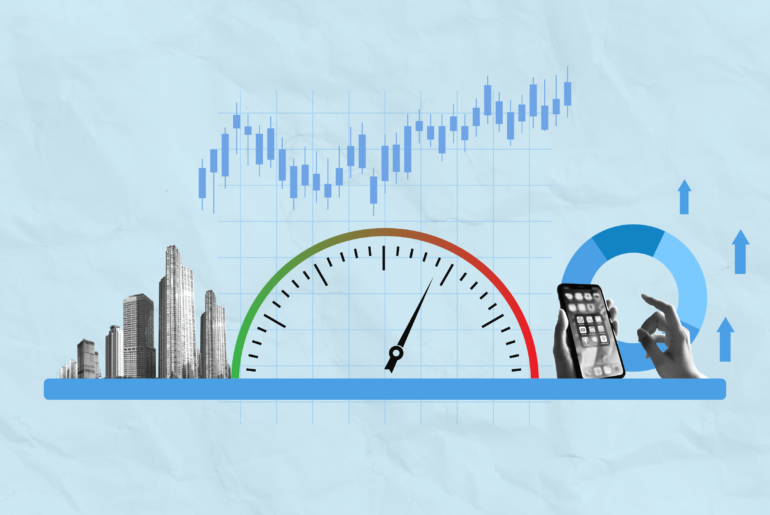Last Updated on Apr 24, 2024 by Manoj Ramachandran
The stock market is volatile. Well, that’s a fact no one can change. So, as an investor, should you act according to the market? The way you invest in the market may define your conscience and the traps you have unconsciously fallen into. Therefore, let’s discuss investment psychology, the role of emotions in investment, eight types of psychological traps and tips to use investment psychology to your benefit.
Table of Contents
What is investment psychology?
Often called behavioural finance, investment psychology uses insights from the field of psychology and applies them to the actions of individuals in trading and other investment applications. It combines psychology and economics to explain why and how investors act and also to analyse how their collective behaviour affects the market.
With an understanding of investment psychology, you can identify investment psychological biases. It can also help you avoid those traps and make informed and conscious decisions.
The role of emotions in investment
In neoclassical economics, people are considered “rational” without giving importance to external and internal factors. On the other hand, behavioural finance attempts to understand humans and their emotions in financial decisions.
Emotions play a crucial role while making investment decisions, just like any other decisions. They can drive you to act irrationally, having significantly detrimental effects on the performance of your portfolios and investment experience.
Most investors are subject to human emotions while making investment decisions, albeit not expressing them openly. If emotions are left unchecked while investing, they can turn the whole experience into a vicious cycle of actions and reactions. For instance, as human beings, we are prone to following trends. We unconsciously get influenced by stories and mass trains of thought, making them our own. Hence, there is no factful base that guarantees a green portfolio if we follow the trend.
Behavioural biases and their impact on investment decisions
Our strongly-ingrained biases exist deep within our psyche. Though they can serve us well in our day-to-day lives, they can impact investment decisions in an opposite way. There are many behavioural biases. Following are four behavioural biases that you should be aware of while investing:
Overconfidence bias
Overconfidence is an emotional bias. While it can be a positive trait and give positive results in some situations, it can also lead to biassed investing decisions. Overconfident investors tend to believe they have more control over their investments than they actually do.
According to research conducted by The Library of Congress, experts often overestimate their own abilities more than the average person. Similarly, overconfident investors may overestimate their abilities to identify successful investments.
Self-attribution bias
Self-attribution is a cognitive phenomenon by which people attribute their successes to their internal factors and failures to situational factors. This bias is often an evidence of self-protection or self-enhancement.
Investors with this bias may become overconfident, which can lead to improper research, underperformed portfolios, and overtrading. To overcome self-attribution bias, investors need to develop accountability mechanisms and track their personal mistakes and successes.
Loss aversion bias
Loss aversion bias makes investors feel worse about the losses than their gains in the stock market. In such cases, the investor is less likely to invest in a stock if it seems risky, even though the reward potential is high.
Investors with this bias may believe that today’s losers may soon outperform today’s winners. It may lead to inefficient research and losses.
Self-control bias
When there is a lack of self-discipline, investors fail to act in pursuit of their long-term goals. They may know they need to save for retirement, but they may fall into the gratification trap because of less self-control, which eventually leads to fewer savings for the future.
In such situations, investors may attempt to make up for the losses by putting the capital at risk or may take anxious, ill-informed decisions. It can put them at risk and increase their chances of a red portfolio.
What’s your investor personality?
There are four different types of investors, each with their distinct behavioural biases. Understanding your personality type can help you determine and meet your long term investment goals while producing better returns. Let’s discuss the four different types of investors’ profiles.
Preserver
A preserver is an investor who places a greater emphasis on financial security and preserving wealth rather than taking risks to grow wealth. They guard their assets and are anxious about losses. The preservers may have the fear of making the wrong decisions. Hence, they face trouble taking action. Moreover, they often obsess over short-term performances. They prefer to avoid making decisions and stick to the status quo.
Independent
An independent investor has original ideas and likes to be involved in the investment process. They have a high risk tolerance. They believe in long-term investment and stick to it to accomplish their financial goals. Unlike followers, they are quite engaged in the financial markets. Independents are analytical and critical thinkers with a belief to take informed decisions. However, they risk the pitfalls of only following their research. Further, it is difficult for them to accept that they are wrong when their investments go downhill.
Follower
A follower investor is passive and tends to follow the lead of their friends and colleagues. They do not have their ideas about investing. Followers may lack interest and/or knowledge of the financial markets. Their decision-making process may also be without any regard for a long-term plan. They usually fall prey to mimicking other investors’ portfolios rather than having their well-researched decisions.
Accumulator
An accumulator investor is interested in accumulating wealth and is confident in their ability to do so. They are risk-takers and rely on themselves. Accumulators usually dig down to the details rather than relying on half the information. They have frequently been successful in prior business endeavours and believe that they will be successful investors as well. Moreover, they are firm believers that whatever path they choose is the correct one.
Psychological traps to avoid while investing
Apart from behavioural biases, there are eight psychological traps that investors can fall victim to. Those eight psychological traps are anchoring, sunk cost, confirmation, blindness, irrational exuberance, pseudo-certainty, superiority and information-overdose trap. Let’s look at them briefly.
Anchoring trap
Anchoring is described as an irrational bias towards an arbitrary benchmark figure such as a purchase price. Investors with this bias put a higher value on the benchmark figure in the decision-making process. Anchoring reflects how emotions and other external factors influence economic decisions.
Relying too heavily on what one thinks can be dangerous, especially when you are investing. For instance, if an investor believes a certain company is successful, they may be too confident that its stocks are a good bet. This preconceived bias may not be totally true for all circumstances.
Sunk cost trap
Sunk cost trap explains why people finish meals that taste bad, keep clothes in their closet they have never worn, and hold on to underperforming investments. It refers to the tendency of people to irrationally follow an activity that is not meeting their expectations.
Investors usually fall into this trap when the base of their decisions are past behaviours and a desire to not lose the time or money they have invested. They continue the underperforming portfolio instead of cutting losses and making the decision that would give them the best outcome going forward. An investor’s emotional commitment to bad investments makes things worse.
Confirmation trap
Confirmation bias refers to the tendency of humans where they naturally favour information that confirms their previously existing information and beliefs. Investors who fall into this trap always seek out information that confirms their existing opinions and ignore facts or data that disprove them.
This behaviour of ignoring facts can be harmful to the portfolio. It can also lead to the ‘herd mentality’, which makes people mimic the financial actions of the majority. Though the confirmation trap promotes self-esteem, it is poor decision making when it comes to investment decisions.
Blindness trap
As people love their comfort zone, they get attached to some of the companies they have invested in. However, situational blindness can make the situation worse. Investors who turn their eye on the losses, shut out the realities and postpone the evil day when the losses have to be confronted, fall into the blindness trap.
Investors become hyper-focused on certain elements of their stock research that they miss other elements that are in plain sight.
Irrational exuberance trap
Irrational exuberance refers to the investor enthusiasm that lacks a real foundation of fundamental evaluation but instead lies on psychological factors. It happens when the investor believes that the rise in prices in the recent past predicts the future. They act as if there is no uncertainty in the market.
This trap gives rise to the bubbles in asset prices i.e. rapid escalation of the market value of assets. But, when the bubble bursts, investors quickly turn to panic selling, sometimes selling their assets for less than they are worth, making more losses.
Pseudo-certainty trap
The aim of investors who have fallen into this trap is to secure their capital investment. Their ideology suggests that they take a higher risk during the bearish trend and take a lower risk during the bullish trend simply to secure the capital.
Though investors will limit their risk exposure when they think their returns are positive, essentially protecting their capital, they might seek more and more risk if it looks like they are heading for a loss. This is largely due to the mentality of winning it all back.
Superiority trap
The superiority trap is extremely dangerous for some investors. In this trap, investors believe they know better than the experts or even the market. They think they are well-educated and/or clever enough to outwit the market.
The problem with this trap is that it may lead the investors in the wrong direction. They are always convinced they are better than the rest. Hence, even if they are losing their fortune, they might stick to their decision and not take experts’ guidance. Moreover, they also fall prey to the other traps mentioned above.
Information overdose trap
In finance, data is the fuel for decision making. Investors who fall into this trap collect and consume enormous amounts of data where they find new data from every source and end up with an information overdose.
Data helps in making an informed decision. However, on the flip side, the overdose of data can lead to confusion, making investors make wrong decisions. This impacts the investors in the long run – they get further confused and lose confidence.
Tips to use the psychology of investing to your benefit
Great investors have the ability to understand the role that psychology plays in investing. If an investor is aware of their flaws and can control emotions while investing, they can avoid bad decisions and have a green portfolio. Here are four tips to use psychology to your advantage:
Conduct research
Devoting time to research is worthy of the effort and helps you make your process of selecting investment instruments easier. Educate yourself, keep on top of the news, and if possible, attend trading seminars and conferences. Knowledge can also help overcome fear and make well-informed decisions.
Stay flexible and review
It is important for stock market investors to remain flexible and consider experimenting timely. Experimentation within reason is one of the best ways to learn in the market. It may also help reduce emotional influences. Further, with experimentation, investors should periodically access their own performances. It may help them create a balanced portfolio.
Be patient
The market tends to change frequently in a short period. This can create panic selling and panic buying. The best way to avoid this is to stick to an investment plan. Consult a financial advisor to come up with an investment plan that suits your needs and situation.
Ignore rumours
Buy the rumour and sell the news; it is indeed an investment saying but basing your decisions on rumours can be a bad idea. The obvious reason is that a lot of them can be untrue, misleading the masses. Therefore, it is always better to avoid taking decisions which are entirely based on rumours in the market.
To conclude
Investment psychology seeks to explain our investment decisions based on mere human tendencies. It defines how our investment decisions root in our inner conscience/deep psyche. To further help us, behavioural finance explains numerous psychological traps to avoid while making investment decisions. Therefore, as an investor, it may be worth your time and effort to learn and educate yourself about investment psychology. To include research in your decision-making process, Tickertape hai na! The Screeners helps you filter stocks and mutual funds using multiple filters and narrow down your search with a few clicks.
FAQs about investment psychology
1. What is investment behaviour?
Investment behaviour explores the relationship between competing demographic factors, personal awareness, and risk-tolerance of individuals in the stock market.
2. Why is investment psychology important?
Investment psychology explores how an investor’s portfolio performs and gets affected because of the decisions that are directly linked to or influenced by emotions. Hence, understanding the investment psychology and psychological traps may help an investor avoid a bad and influenced decision.
3. What are the types of psychological traps?
There are numerous psychological traps. Eight of them are anchoring, sunk cost, confirmation, blindness, irrational exuberance, pseudo-certainty, superiority, and information-overdose trap.
- Top 10 High-Return Mutual Funds in India (2024) - Nov 19, 2024
- Where to Invest Money in India? 15 Investment Options to Explore - Nov 18, 2024
- Best Long Term Stocks to Buy in NSE India for 2024 - Nov 18, 2024




